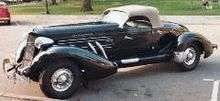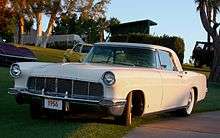Gordon Buehrig
Gordon Miller Buehrig (B-yur-rig) (June 18, 1904 – January 22, 1990) was an automobile designer. Born in Mason City, Illinois, he had early design experience with Packard, General Motors and Stutz. In 1929, he was responsible for designing the bodies (built by Weymann) of the Stutz Black Hawks entered at Le Mans.[1] At age 25 he became chief body designer for Duesenberg, where he designed the Model J. He joined the Auburn Automobile Company of Auburn, Indiana in 1934, producing the famous 1935 851 Boattail Speedster, based on the work of Alan Leamy .[1] (A kit copy of this car was driven by the title faceman on NBC's "Remington Steele".) He also designed the distinctive Cord 810/812, the latter recognized for its originality by the Museum of Modern Art in 1951.
Gordon Buehrig | |
|---|---|
| Born | June 18, 1904 Mason City, Illinois |
| Died | January 22, 1990 (aged 85) Grosse Pointe Woods, Michigan |
| Occupation | automobile designer |
| Spouse(s) | (1) Elizabeth ("Betty") Whitten (2) Kathryn ("Kay") Lundell Benzin |


In 1949, Buehrig joined Ford, where his projects included the 1951 Victoria Coupe and the 1956 Continental Mark II. He invented the removable T-top, patented 5 June 1951, which was used in the aborted TASCO sports car.[2][3]
Retiring from Ford in 1965, Buehrig taught for five years at the Art Center College of Design in California. In 1979, he produced the design for the Buehrig motor car, a limited-production carriage roof coupe.
Buehrig died in Grosse Pointe Woods, Michigan, on January 22, 1990, at the age of 85. His cremated remains are buried in Roselawn Cemetery in Auburn.
He was one of 25 candidates for Car Designer of the Century, an international award given in 1999 to honor the most influential automobile designer of the 20th century. It was won by Giorgetto Giugiaro.
Buehrig was honored by the Scarab Club in Detroit, an artists' club with a show of his work and asking him to sign the beam in the banquet hall. During that event he revealed that one of his favorite vehicles was the Duesenberg 20 Grand, which was developed for the Chicago World's Fair of 1933 along with three other vehicles. Buehrig had read Le Corbusier's Toward an Architecture and was deeply inspired by it. Buehrig's work also led to front-wheel-drive Oldsmobile cars and also inspired a Chrysler vehicle with its hood design.
He was inducted into the Automotive Hall of Fame in 1989.[4]
External links
References
- Buehrig, Gordon M., and Jackson, William S. Rolling Sculpture: A Designer and his Work. (Newfoundland, NJ: Haessner Publishing Inc.), 1975.
- This Day In History - June 5: Automotive Archived 2010-02-11 at the Wayback Machine
- Coachbuilt: Gordon Buehrig 1904-1990
- "Gordon Buehrig". Hall of Fame Inductees. Automotive Hall of Fame. Archived from the original on March 19, 2016. Retrieved March 6, 2016.